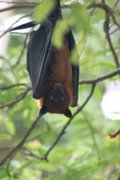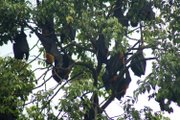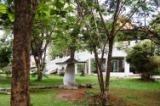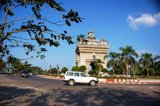Anybody growing up in the 1960s would probably remember a song called Ole-ole Bandung (Souvenirs from Bandung). The lyrics had something to do with a short blouse being cut into a sarong or something like that. The reason for this song or rather the lyrics, I was to find out, is that the traditional costume for Sundanese women (who you find in large numbers in Bandung) is a sarong worn just half way down the calf with a kebaya (also known in Kelantan as baju Bandung) on top.
I was in for another surprise where the Sundanese were concerned. It happened when we walked into a restaurant for lunch on the way to Tangkuban Parahu, a mountain range housing six dormant volcanoes, about 20kms out of Bandung town. The girl who greeted us put up her hands in a wai position. Being Thai and being terribly polite especially with sweet-looking young things, I instinctively put up my own hands and replied “Sawatdi khrap” before realising that I was not in Thailand. (Wai is the Thai greeting and involved putting the palms together at about chin level).
It turned out that the Sundanese greeting happened to be a version of the wai, although they do not call it a wai. In fact they do not call it anything except a Sundanese greeting. And who better to demonstrate this than a Sundanese girl in traditional costume. She did it with such beauty and grace. How I wish we were 30 years younger.
Our age did not stop the driver from taking the trouble to extol the virtues of women from the various areas of Java, though. Sunda, Cirebon, Jakarta, Semarang, Surabaya, Yogyakarta and so on. My friend, whose ancestry can be traced to both the royalty of Cirebon and the pirates of Sulawesi was all ears. Our driver, being Javanese himself, was naturally trying to convince us that the best candidates for wives were Javanese. Moreover, he said, getting married in Indonesia would only cost us in the range of two million rupiah or so. Now, that is food for thought, especially for two poor, old bachelors.
Anyway let us just leave the wives part out of it for the moment. Too many damsels and all of them managed to have a distress story of some sort to tell. We seemed spoiled for choice and somehow it looked much easier to remain bachelors, especially at meal times.
Meals in Bandung usually consist of a fish dish. Of course there is also sapi (bull) meat. Not lembu, mind you. The sapi meat is usually served as miniature satays. A word of advice. If you are wearing dentures stay as far away from it as possible. The sapi must have had their fair share of skirmishes with quite a few local matadors judging from the tougness of their meat.
But hardly had we set foot on Indonesian soil and my friend was already talking about pacel lele. It is actually deep fried catfish eaten with vegetables and sambal. In the interest of gastronomic science, he was trying to determine if there was any difference in tastes between the pacel lele served at Indonesian restaurants in Kuala Lumpur and those found in Bandung. Much like he once went to Hat Yai, Bangkok and Chiang Mai to see if the tomyams there and those in Kuala Lumpur taste the same.
On our second night in Bandung, after hopping into a taxi, we politely requested him to take us in double time to the nearest restaurant selling pacel lele. The taxi driver must have misunderstood our Sundanese dialect because he deposited us near Jalan Sudirman where we found lots of shops and stalls selling bakmee but not pacel lele. We hopped into another taxi and asked the driver to take us to the nearest Muslim restaurant, instead.
This time there was no room for mistake and the waitress in tudung kind of convinced us we were in the right type of restaurant at last. Called Ampera, it is located in Jalan Kebun Kawung, somewhere between the Bandung Governor’s Residence and the Railway Station.
The deep fried chicken drumstick served here more than compensated for the missing catfish. Having found Sundanese food rather bland over the previous two days, my friend and I tucked into the sambal with gusto. Only this time it was not so bland. Being Thai I pride myself in my ability to stomach hot food. But this was something else altogether. It was like a few mini explosions had just gone on inside my mouth. I must say the numbing sensation moved us to tears and we were sweating in places that had no right to sweat at that hour of the night. But it was nothing that two tall glasses of freshly-squeezed orange juice (locally known as jeruk) could not take care of. Naturally there was no sirap Bandung. Sirap Bandung is a fallacy propagated by the back street vendors in Malaysia. Just like there is no nasi goreng Pattaya in the Thai seaside resort. Now I actually begin to wonder whether what my late grandmother called baju Bandung actually originated in Bandung at all.
But Bandung, being close to 800 metres above sea level has a rather cool temperature. It seemed to rain most of the four days we were there. I suppose if the temperature dropped lower than normal, the people of Bandung can always visit Ampera. The sambal would certainly warm them up somewhat. We did manage to find our pacel lele the very next day. Wonder of all wonders it was at a restaurant located 20 metres from our hotel.
Of course, pacel lele was not the only thing my friend was fond of. The other is fighting with taxi drivers. He seemed to have taken the fight from the streets of KL to back streets of Bandung over their reluctance to use the meter after midnight. Still they were a whole lot friendlier than their counterparts in KL. None argued or protested when we paid them half of what they asked. They were smiling broadly because probably they were still making a hefty profit.
I was just smiling because the taxi drivers did not take us to some dark alley and relieve us of all our worldly and unworldly possessions. After all, picking a fight with taxi drivers at three in the morning, whether in KL, Bangkok or Bandung is not very clever. But try telling that to my friend, the gaped crusader, who felt that justice must prevail and “broken meters” should be repaired.
We did encounter some very pleasant taxi drivers as well in Bandung. And my friend was not averse to giving a big tip to the honest drivers. If only they knew how much more they could have made from the tips if they had just used the meters in the first place.
The first thing I did after arriving back in Kuala Lumpur was to go check the next available cheap flight (translated as RM0.00) to Bandung. We were not quite finished with the pacel lele, the sambal in Ampera and the Bandung taxi drivers just yet. And, I had to come back to KL to find out that a replica of the Java Man is actually exhibited in the Bandung Museum. Now that us something I would like to have a look at. Of course, there is still the two million rupiah question to be answered. Tsk, tsk the things we do in the name of journalism.
Thursday, September 21, 2006
Subscribe to:
Post Comments (Atom)



















No comments:
Post a Comment